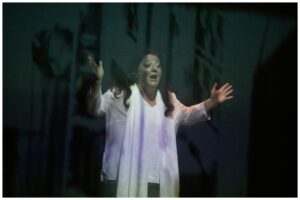
Royal Opera House 2022-23 Review: Woman at Point Zero
A Magical Score Frames an Unsparing Story in Bushra El-Turk’s Latest Stage Work
By Benjamin PoorePhoto: Camilla Greenwell/Royal Opera House 2023
The Linbury Theatre at the Royal Opera House has been home to some of the most incisive and bracing opera happening at Covent Garden in recent times. Work there has been self-consciously political, physical and experimental. Most notable is Laura Bowler’s “The Blue Woman,” directed by Katie Mitchell, Oliver Leith’s “Last Days,” and “Least Like The Other, Searching for Rosemary Kennedy” by Brian Irvine and Netia Jones.
The latest opera in this series coincides with the Royal Opera House’s Engender Festival 2023, an exploratory initiative celebrating the work of women and non-binary opera creatives. “Woman at Point Zero” is by Bushra El-Turk, librettist Stacy Hardy and director Laila Soliman. The 55-minute work is a co-production with Ghent-based workshop LOD Muziektheater, Britten-Pears Arts, Shubbak Festival London, All Aria’s Festival, the Aix-en-Provence Festival, and the Grand Théâtre de Luxembourg. This UK premiere, a London extension of the recently-concluded Aldeburgh Festival, followed its debut last year at the Aix. Ensemble ZAR, a group that combines instruments from European, Middle Eastern, and Asian musical traditions, was conducted by Kanako Abe.
“Woman at Point Zero” is based on the 1975 novel by Egyptian feminist Nawal El Saadawi, whose book was based on her experiences with inmates at Qanatir prison. Stacy Hardy’s libretto sees Sama meet Fatma. The former is making a documentary about violence against women, and the latter is a sex worker imprisoned for murdering a pimp. Her life story unfolds through a mixture of spoken (amplified) dialogue and aria-like bursts of intense reflection, despite her initial prickliness about Sama’s motives.
The use of dialogue allows much detail to unfold, harrowing and unsparing, including female genital mutilation, confinement, the travails of sex work, educational inequality, and her political awakening and disillusionments. There is an iridescence to Fatma’s rage and defiance, which gleams ever more distinctly as their dialogue develops. Sama’s camera, given to us as live video, takes us into uncomfortable closeness. This is another perspective on the stage in a piece that is all about multiplying points of view. The set is spare and includes a raised platform from which the pair occasionally descend for more reflective interludes. Their exchanges buttressed and intensified by documentary video footage, by Bissane Al Charif and Julia König, of the source material projected behind. Multiplying this testimony reminds of the ubiquity of these stories, but also gives the piece the stamp of archival authenticity, laying bare the artifice of the work and its motivations. The collage-like presentation recalls Irvine and Jones’ work on “Rosemary Kennedy” especially. Costumes, by Eli Verkeyn, are unobtrusive and ordinary. These experiences all too ordinary. The lighting, by Loes Schakenboes, is an evocative but straightforward play of brightness and shadow, with a narrow palette.
It is spare and direct in its realization. The text is emphatic and bluff, and the musicians visible, who encircle the platform, with the conductor onstage too. They add another layer of dramatic intensity by functioning, at times, like a kind of chorus. Sometimes cheering, whistling, and adopting the pose of the men who have abused Fatma. The rest of the time, they play Bushra El-Turk’s glittering score. In a roundabout way it is rather like the mercurial choruses in Bach’s Passions.
“Woman at Point Zero” is straight-talking. If you don’t like artworks that are upfront with you about what they’re about, then you will not like this. It would indeed be heavy weather but for the essential leavening agent of Bushra El-Turk’s magical score. She has an intuitive grasp of the timbral possibilities gathered in Ensemble ZAR’s idiosyncratic ensemble. A preponderance of higher instrumental give her writing an unearthly, haunted character, which brittleness balanced by more diaphanous, dreamlike moments. At times, there are reminders of George Benjamin’s frangible, gleaming scores for the opera house, but achieved by various combinations of kamancha, shō, and taegŭm, with shards and splinters of recorder, crumhorn, and duduk adding yet more textural interest to these glittering surfaces. Other moments smolder with cello and accordion in rougher, more streetwise sounds. The very distant cousin, perhaps, of Astor Piazzolla or even Kurt Weill. But these are echoes rather than influences. El-Turk’s language is wholly her own and atmospherically theatrical.
The vocal writing is the one area that could be given greater dramatic shrift. There are soaring passages that draw on vocal figures from folk music, as well as the searching, pleading melisma of Claudio Monteverdi or Hildegard von Bingen, that punctuate the expositional sequences and temper the fierceness of the text. These expansive moments provide much needed reflection and intimacy, and more of them would deepen this hurtling theatrical experience.
Dima Orsho as Fatma is made to sing amplified. It is a pity given the intensity and richness of her sound, and one wonders whether some fleet-footed sound design couldn’t let her ring out more naturally. Orsho has enormous vocal presence and uses her long lines to show a host of colors and timbres, underscoring the character’s own multifaceted nature. Her counterpart, Carla Nahadi Babelegoto, is more taut and declarative, with sharper vocal elbows suggestive of someone driven to understand the brutal world set out by text and video. Another fascinating and adventurous piece of programming at the Linbury, whose recent collaborations are a credit to the Royal Opera.


